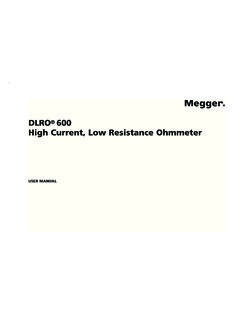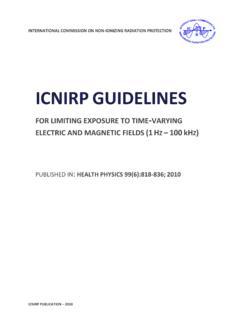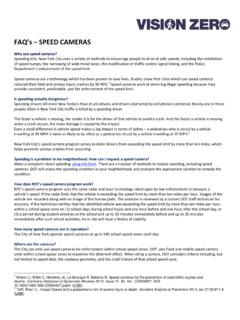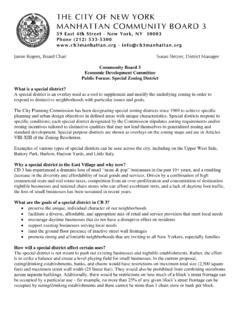Transcription of NIOSH Publication No. 98-131, Worker Deaths by …
1 Worker Deaths BY ELECTROCUTIONA Summary of NIOSH Surveillanceand Investigative DEPARTMENT OF HEALTH AND HUMAN SERVICESP ublic Health ServiceCenters for Disease Control and PreventionNational Institute for Occupational Safety and HealthMay 1998iiDISCLAIMERM ention of any company or product does not constitute endorsement by theNational Institute for Occupational Safety and HealthThis document is in the public domain and may be freely copied or of this and other NIOSH documents are available from:Publications Dissemination, EIDN ational Institute for Occupational Safety and Health4676 Columbia ParkwayCincinnati, OH 45226-1998 Fax number: (513) 533-8573 Telephone number: 1-800-35- NIOSH (1-800-356-4674)E-mail: receive other information about occupational safety and healthproblems, call 1-800-35- NIOSH (1-800-356-4674), or visit the NIOSH Home Pageon the World Wide Web at ( NIOSH ) Publication No.
2 98-131iiiCONTENTSLIST OF TABLES .. ivLIST OF FIGURES .. ivACKNOWLEDGMENTS .. vPUBLIC HEALTH SUMMARY .. (Nancy A. Stout, )PART IELECTROCUTION-RELATED FATALITIESOVERVIEW OF ELECTRICAL HAZARDS .. 5(Virgil Casini, )EPIDEMIOLOGY OF electrocution FATALITIES .. 9(Suzanne Kisner, , Virgil Casini, )PREVENTION: ELEMENTS OF AN ELECTRICAL SAFETY PROGRAM .. 20(Virgil Casini, ) 22 PART IIFATALITY ASSESSMENT AND CONTROL EVALUATION (FACE)SUMMARY REPORT ABSTRACTS, 1982-1994 ELECTROCUTIONSFACE electrocution CASES .. 26ivLIST OF TABLEST able 1. Estimated Effects of 60 Hz AC Currents ..7 LIST OF FIGURESF igure 1. Frequencies and Rates of electrocution Deaths Identified by NTOF by Year, 1980-1992 ..10 Figure 2. Frequencies and Rates of electrocution Deaths Identified by NTOF by Age Group, 1980-1992 ..11 Figure 3. Frequencies and Rates of Electrocutions Identified by NTOF by Industry, 1980-1992.
3 12 Figure 4. Frequencies and Rates of Electrocutions Identified by NTOF by Occupation, 1980-1992 ..12 Figure 5. Frequencies of electrocution Deaths Identified by FACE by Age Group, 1982-1994 ..14 Figure 6. Frequencies of electrocution Deaths Identified by FACE by Industry, 1982-1994 ..14 Figure 7. Frequencies of electrocution Deaths Identified by FACE by Occupation, 1982-1994 ..15 Figure 8. Frequencies of electrocution Incidents Identified by FACE by Month, 1982-1994 ..16 Figure 9. Frequencies of electrocution Incidents Identified by FACE by High Voltage Level (>600 Volts), 1982-1994 ..17 Figure 10. Frequencies of electrocution Incidents Identified by FACE by Low Voltage Level (<600 Volts), 1982-1994 ..17 ACKNOWLEDGMENTSThe authors would like to express our gratitude to the following people for their contributions in thedevelopment of this electrocution Monograph:Technical reviewDavid Wallis, OSHA, Washington, A.
4 Broderick, Construction Safety Council, Hillside, IllinoisOrville V. Paul, Jr., Lawrence Livermore National Laboratory, Livermore, CaliforniaLaurence D. Reed, Division of Physical Sciences and EngineeringTed A. Pettit, Division of Safety ResearchTimothy J. Pizatella, DSRH erbert I. Linn, DSRData analysis and technical reviewStephanie G. Pratt, DSRWord processing and document preparationSuetta J. Marsh, DSRT eresa L. Dalton, DSRK athy J. Boyce, DSRG raphic and Document layoutJoyce R. Spiker, DSRG raphics technical reviewPamela S. Hixon, DSRE ditorial reviewHerbert I. Linn, DSRL inda L. Morton, DSRC over DesignHerbert I. Linn, DSRvPUBLIC HEALTH SUMMARYWhat are the hazards?Based on data from the NIOSH National Traumatic Occupational Fatalities (NTOF) surveillancesystem, electrocutions were the fifth leading cause of death from 1980 through 1992. The 5,348deaths caused by electrocutions accounted for 7% of all fatalities and an average of 411 Deaths can a Worker be exposed or put at risk?
5 Electricity is present at most jobsites, and many American workers, regardless of industry or occupa-tion, are exposed to electrical energy daily during the performance of their tasks. These hazardousexposures may exist through contact with an object as seemingly innocuous as a broken light bulb toan energized overhead recommendations has the federal government made to protect workers health?The Occupational Safety and Health Administration (OSHA) addresses electrical safety in Subpart S29 CFR through of the General Industry Safety and Health Standards. Thestandards contain requirements that apply to all electrical installations and utilization equipment,regardless of when they were designed or installed. Subpart K of 29 CFR through the OSHA construction safety and health standards contain installation safety requirements forelectrical equipment and installations used to provide electric power and light at the jobsite.
6 Thesesections apply to both temporary and permanent installations used on the jobsite. Additionally, theNational Electrical Code (NEC) and the National Electrical Safety Code (NESC) comprehensivelyaddress electrical safety regulations. NIOSH recommendations focusing on prevention are included inthis Technical can more information be found?The references at the end of this document provide a useful inventory of published reports and litera-ture. Additional information from NIOSH can be obtained by calling the following number:1-800-35- NIOSH (800-356-4674)viiIN TRODUCTIONN ancy A. Stout, American workers are exposed to electrical energy daily during the performance of their monograph highlights the magnitude of the problem of occupational electrocutions in the ,identifies potential risk factors for fatal injury, and provides recommendations for developing effectivesafety programs to reduce the risk of monograph summarizes surveillance data and investigative reports of fatal incidents involvingworkers who contacted energized electrical conductors or equipment.
7 The surveillance data werederived from the National Traumatic Occupational Fatalities (NTOF) surveillance system maintainedby the National Institute for Occupational Safety and Health ( NIOSH ). The NTOF data are based ondeath certificates of workers 16 years or older who died from a traumatic injury in the workplace. Thefatality investigations were conducted as part of the NIOSH Fatality Assessment and Control Evalua-tion (FACE) program. FACE is a research program for the identification and investigation of fataloccupational injuries. The goal of the FACE program is to collect information on factors that mayhave contributed to traumatic occupational fatalities using an epidemiologic approach, and to developand disseminate recommendations for preventing similar events in the on the NTOF surveillance data for the period from 1980 through 1992, 5,348 workers diedfrom contact with electrical energy (an average of 411 Deaths per year).
8 Electrocutions were the fifthleading cause of death , accounting for 7% of all workplace fatalities. In the 12 year period from 1982through 1994, NIOSH investigated 224 electrocution incidents which resulted in 244 Worker I of this monograph provides: an overview of electrical hazards, including the effects of electricalenergy on the human body; a comprehensive summary of the epidemiology of occupational electrocu-tions based on NTOF and FACE data which identifies common risk factors for fatal injury due tocontact with electrical energy; and recommendations for elements of an effective electrical safetyprogram for the prevention of workplace electrocutions. Part II includes a summary abstract for all 224 FACE electrocution investigative reports prepared by NIOSH for further information and hope is that this monograph will serve as a valuable resource for safety and public health profes-sionals, safety and health trainers, researchers, and others who can affect the prevention of occupa-tional IELECTROCUTION-RELATED FATALITIESOVERVIEW OF ELECTRICAL HAZARDSV irgil Casini, is a ubiquitous energy agent to which many workers in different occupations and industriesare exposed daily in the performance of their duties.
9 Many workers know that the principal dangerfrom electricity is that of electrocution , but few really understand just how minute a quantity of electri-cal energy is required for electrocution . In reality, the current drawn by a tiny watt, 120-volt lamp,passed from hand to hand or hand to foot across the chest is sufficient to cause Thenumber of people who believe that normal household current is not lethal or that powerlines areinsulated and do not pose a hazard is alarming. Electrocutions may result from contact with an objectas seemingly innocuous as a broken light bulb or as lethal as an overhead powerline, and have affectedworkers since the first electrical fatality was recorded in France in 1879 when a stage carpenter waskilled by an alternating current of 250 information in the following two sections (DEFINITIONS and EFFECTS OF ELECTRI-CAL ENERGY) is intended as a basic explanation of electricity and the effects of electrical otherwise indicated, information in these sections is derived from OSHA electrical standards,3,4the National Electrical Code (NEC),5 and the National Electrical Safety Official definitions ofelectrical terms can be found in these same is the flow of an atom s electrons through a conductor.
10 Electrons, the outer particles ofan atom, contain a negative charge. If electrons collect on an object, that object is negativelycharged. If the electrons flow from an object through a conductor, the flow is called electric primary terms are used in discussing electricity: voltage, resistance, current, and is the fundamental force or pressure that causes electricity to flow through a conductor andis measured in volts. Resistance is anything that impedes the flow of electricity through a conductorand is measured in Ohms. Current is the flow of electrons from a source of voltage through aconductor and is measured in amperes (Amps). If the current flows back and forth (a cycle) througha conductor, it is called alternating current (AC). In each cycle the electrons flow first in onedirection, then the other. In the United States, the normal rate is 60 cycles per second [or 60 Hertz(Hz)].















